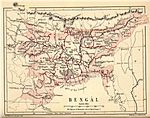| History of Bengal |
|---|
 |
| History of South Asia |
|---|
 |
The city of Chattogram (Chittagong) is traditionally centred around its seaport which has existed since the 4th century BCE. One of the world's oldest ports with a functional natural harbor for centuries, Chittagong appeared on ancient Greek and Roman maps, including on Ptolemy's world map. Chittagong port is the oldest and largest natural seaport and the busiest port of Bay of Bengal. It was located on the southern branch of the Silk Road. The city was home to the ancient independent Buddhist kingdoms of Bengal like Samatata and Harikela.[1] It later fell under of the rule of the Gupta Empire, the Gauda Kingdom, the Pala Empire, the Chandra Dynasty, the Sena Dynasty and the Deva Dynasty of eastern Bengal.[2] Arab Muslims traded with the port from as early as the 9th century. Historian Lama Taranath is of the view that the Buddhist king Gopichandra had his capital at Chittagong in the 10th century. According to Tibetan tradition, this century marked the birth of Tantric Buddhism in the region.[3] The region has been explored by numerous historic travellers, most notably Ibn Battuta of Morocco who visited in the 14th century. During this time, the region was conquered and incorporated into the independent Sonargaon Sultanate by Fakhruddin Mubarak Shah in 1340 AD.[4] Sultan Ghiyasuddin Azam Shah constructed a highway from Chittagong to Chandpur and ordered the construction of many lavish mosques and tombs. After the defeat of the Sultan of Bengal Ghiyasuddin Mahmud Shah in the hands of Sher Shah Suri in 1538, the Arakanese Kingdom of Mrauk U managed to regain Chittagong. From this time onward, until its conquest by the Mughal Empire, the region was under the control of the Portuguese and the Magh pirates (a notorious name for Arakanese) for 128 years.[3]
The Mughal commander Shaista Khan, his son Buzurg Umed Khan, and Farhad Khan, expelled the Arakanese from the area during the Conquest of Chittagong in 1666 and established Mughal rule there. After the Arakanese expulsion, Islamabad, as the area came to be known, made great strides in economic progress. This can mainly be attributed to an efficient system of land-grants to selected diwans or faujdars to clear massive areas of hinterland and start cultivation. The Mughals, similar to the Afghans who came earlier, also built mosques having a rich contribution to the architecture in the area. What is called Chittagong today also began to have improved connections with the rest of Mughal Bengal. The city was occupied by Burmese troops shortly in First Anglo-Burmese War in 1824 and the British increasingly grew active in the region and it fell under the British Empire. The people of Chittagong made several attempts to gain independence from the British, notably on 18 November 1857 when the 2nd, 3rd, and 4th companies of the 34th Bengal Infantry Regiment stationed at Chittagong rose in rebellion and released all the prisoners from jail but were suppressed by the Kuki scouts and the Sylhet Light Infantry (10th Gurkha Rifles).[3]
Chittagong grew at the beginning of the twentieth century after the partition of Bengal and the creation of the province of Eastern Bengal and Assam.[5] The construction of the Assam Bengal Railway to Chittagong facilitated further development of economic growth in the city. However, revolutionaries and opposition movements grew during this time. Many people in Chittagong supported Khilafat and Non-Cooperation movements.
- ^ "Showcasing glorious past of Chittagong". The Daily Star. 31 March 2012.
- ^ Roy, Niharranjan (1993). Bangalir Itihas: Adiparba Calcutta: Dey's Publishing, ISBN 81-7079-270-3, pp.408-9
- ^ a b c Dey, Arun Bikash (2012). "Chittagong City". In Sirajul Islam; Miah, Sajahan; Khanam, Mahfuza; Ahmed, Sabbir (eds.). Banglapedia: the National Encyclopedia of Bangladesh (Online ed.). Dhaka, Bangladesh: Banglapedia Trust, Asiatic Society of Bangladesh. ISBN 984-32-0576-6. OCLC 52727562. OL 30677644M. Retrieved 14 November 2024.
- ^ "About Chittagong:History". Archived from the original on 3 November 2014. Retrieved 30 December 2013.Retrieved: 30 December 2013
- ^ "India's History : Modern India : The First Partition of Bengal : 1905".